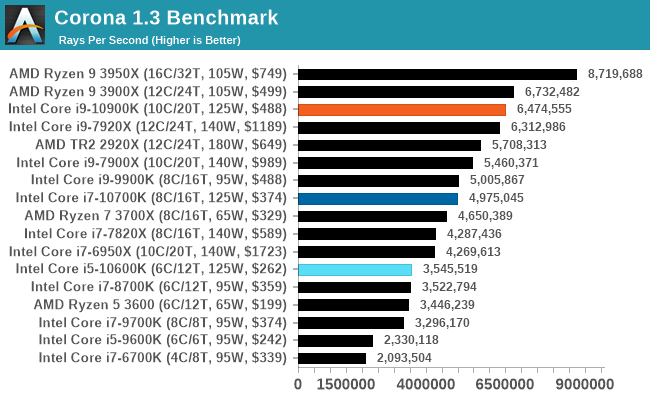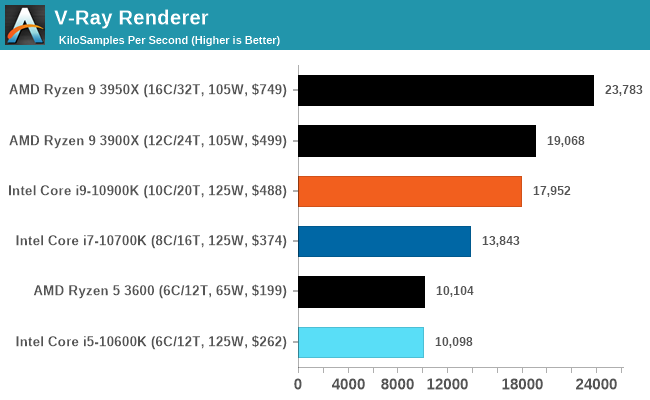The Intel Comet Lake Core i9-10900K, i7-10700K, i5-10600K CPU Review: Skylake We Go Again
by Dr. Ian Cutress on May 20, 2020 9:00 AM EST- Posted in
- CPUs
- Intel
- Skylake
- 14nm
- Z490
- 10th Gen Core
- Comet Lake
CPU Performance: Rendering Tests
Rendering is often a key target for processor workloads, lending itself to a professional environment. It comes in different formats as well, from 3D rendering through rasterization, such as games, or by ray tracing, and invokes the ability of the software to manage meshes, textures, collisions, aliasing, physics (in animations), and discarding unnecessary work. Most renderers offer CPU code paths, while a few use GPUs and select environments use FPGAs or dedicated ASICs. For big studios however, CPUs are still the hardware of choice.
All of our benchmark results can also be found in our benchmark engine, Bench.
Crysis CPU Render
One of the most oft used memes in computer gaming is ‘Can It Run Crysis?’. The original 2007 game, built in the Crytek engine by Crytek, was heralded as a computationally complex title for the hardware at the time and several years after, suggesting that a user needed graphics hardware from the future in order to run it. Fast forward over a decade, and the game runs fairly easily on modern GPUs, but we can also apply the same concept to pure CPU rendering – can the CPU render Crysis? Since 64 core processors entered the market, one can dream. We built a benchmark to see whether the hardware can.
For this test, we’re running Crysis’ own GPU benchmark, but in CPU render mode. This is a 2000 frame test, which we run over a series of resolutions from 800x600 up to 1920x1080. For simplicity, we provide the 1080p test here.
This is one of our new benchmarks, so we are slowly building up the database as we start regression testing older processors.

The Core i9-10900K scores 15 FPS at 800x600, which is just about playable.
Corona 1.3: Performance Render
An advanced performance based renderer for software such as 3ds Max and Cinema 4D, the Corona benchmark renders a generated scene as a standard under its 1.3 software version. Normally the GUI implementation of the benchmark shows the scene being built, and allows the user to upload the result as a ‘time to complete’.
We got in contact with the developer who gave us a command line version of the benchmark that does a direct output of results. Rather than reporting time, we report the average number of rays per second across six runs, as the performance scaling of a result per unit time is typically visually easier to understand.
The Corona benchmark website can be found at https://corona-renderer.com/benchmark

Blender 2.79b: 3D Creation Suite
A high profile rendering tool, Blender is open-source allowing for massive amounts of configurability, and is used by a number of high-profile animation studios worldwide. The organization recently released a Blender benchmark package, a couple of weeks after we had narrowed our Blender test for our new suite, however their test can take over an hour. For our results, we run one of the sub-tests in that suite through the command line - a standard ‘bmw27’ scene in CPU only mode, and measure the time to complete the render.
Blender can be downloaded at https://www.blender.org/download/

V-Ray
We have a couple of renderers and ray tracers in our suite already, however V-Ray’s benchmark came through for a requested benchmark enough for us to roll it into our suite. We run the standard standalone benchmark application, but in an automated fashion to pull out the result in the form of kilosamples/second. We run the test six times and take an average of the valid results.
This is another one of our recently added tests.

POV-Ray 3.7.1: Ray Tracing
The Persistence of Vision ray tracing engine is another well-known benchmarking tool, which was in a state of relative hibernation until AMD released its Zen processors, to which suddenly both Intel and AMD were submitting code to the main branch of the open source project. For our test, we use the built-in benchmark for all-cores, called from the command line.
POV-Ray can be downloaded from http://www.povray.org/

Interestingly the Core i9 with only 10C outperforms the 12C Ryzen 9 3900X here, likely due to the higher sustained frequency of the Intel chip. We clocked 220W on our Intel chip for this test however, well beyond the 120W of the AMD processor.












220 Comments
View All Comments
Gastec - Friday, May 22, 2020 - link
Basically you just have to type "allyourbasearebelongtous +$50/surprisemechanic" and you get all the framerate you want in your favorite multiplayer FPShooter.Boshum - Wednesday, May 20, 2020 - link
I think it's a viable alternative to Ryzen 3000, so it's not pointless. It's about equal in performance for most people. A little more expensive and power hungry core for core, but it's more of a flavor thing now. It's still better for certain gaming and application scenarios. Hyperthreading makes the low to midrange a much more reasonable option too, with heat and power being no big deal there. The only place it can't compete with Ryzen is at the very high end for power users doing heavy multi-core work.Dribble - Wednesday, May 20, 2020 - link
I'd be the sort of person to look at a 10700K but power usage is just too high. I want to be able to stick a high end air cooler on it, o/c and still have it run pretty quiet. I'd have to go water with one of these and I can't be bothered with that. Not worth it for the small performance increment over more efficient chips.IBM760XL - Wednesday, May 20, 2020 - link
Agreed. The 10700K and 10900K use more power per core than my ancient-but-trusty 2500K, at least with stock settings. Sure, the new chips get somewhat better IPC, but I can't justify switching from a Sandy Bridge that's nice and quiet even at 100% load, to a Comet Lake that will require Serious Cooling to have an outside chance of being as quiet.I could look at lower-end hex-core Comet Lake chips instead, but why would I do that when I could just as well get an octo-core Ryzen 7 3700, or a Ryzen 5 3600 that will have better performance than an i5-10500?
Boshum - Wednesday, May 20, 2020 - link
I should think the 10500 and 3600 would be pretty close at stock, though you have more overclocking options with the 3600. It's the future Rocket Lake vs Ryzen 4000 options that is more interesting.warrenk81 - Wednesday, May 20, 2020 - link
typo in the dropdown for the final page, move/more.colonelclaw - Wednesday, May 20, 2020 - link
Grammar error, too. Less/fewer.Flunk - Wednesday, May 20, 2020 - link
Well, Intel's back on top for gaming, by a small marging, with chips that can fry an egg. Maybe it'll force AMD to lower their prices on their high-end chips. I don't really fancy a 250+ Watt CPU.DrKlahn - Wednesday, May 20, 2020 - link
You can already get the 3900x for $410 on Amazon. Unless you have a use case that heavily favors Intel that would seem to be a pretty good value already. A good B450 board capable of handling it could be had for not much more than the difference in chip cost (provided that fits your needs).Irata - Wednesday, May 20, 2020 - link
Yup, and like the article says that includes an HSF that will do the job.Contrast that with the 10900k which retails for $530 on Newegg (not available) and which requires you to spend $ 200+ for a proper cooling set up and you are looking at $ 410 vs. $ 730, i.e. paying 56% more for the 10900k. And that does not even include case fans, mainboard, PSU.
If gaming is what one is after, the 9700k looks much more attractive than the 10900k.